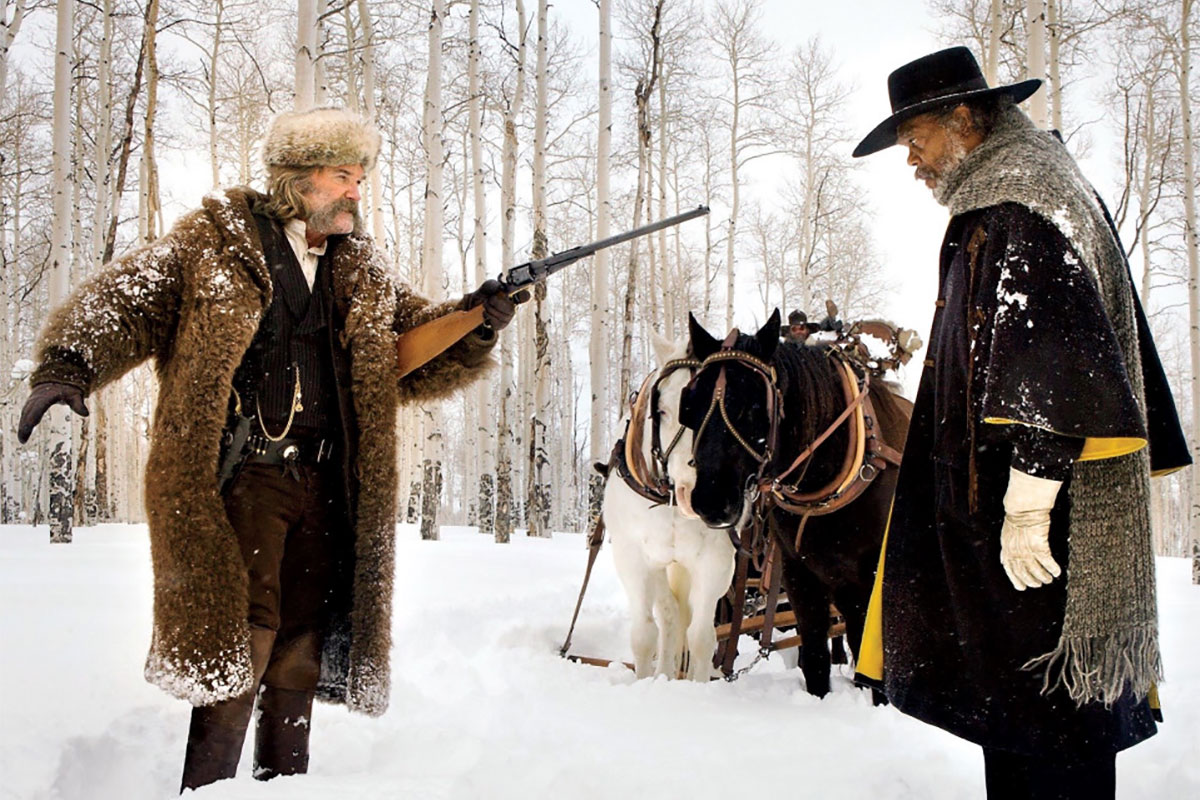Quentin Tarantino’s 8th film, The Hateful Eight, follows in the same genre as his last film. Moreover, this is the third film in a row that the Oscar-winning director has chosen to use a non-contemporary setting. It makes sense that he would want to make another shoot ’em up Western. A lot of the films QT adored before his film career took off were also Westerns. With Django Unchained, we got a glimpse of his unique style, set in the American frontier. What we get in The Hateful Eight are the same violent and humorous trademarks with a little fuller feel of the genre.
The film is set in Wyoming in the late 19th century, sometime after the death of President Lincoln. The opening follows a stagecoach trudging through foot-deep snow, outrunning an approaching blizzard. On board, John Ruth and his captive bounty, Daisy Domergue, make their way to the city of Red Rock. The trip is long and treacherous. Before finding refuge, Ruth reluctantly allows two more travelers aboard: A Union officer-turned-bounty hunter, Marquis Warren, and the sheriff of Red Rock himself, Chris Mannix, played by Samuel L. Jackson and Walton Goggins respectively. Filling a good portion of the first hour of the movie, the trip feels like an epilogue to the upcoming events. Honestly, not much would have been lost from the story, had these opening scenes been cut entirely from a film that is already more than three hours long.
Ultimately, the film’s pacing is rather slow throughout. Tarantino, who is known to shower elaborate violence throughout his scripts, gives only a glimpse of bloodshed in the first half of the film, mostly through the blows Domergue takes to the face for speaking out of turn. Instead of getting to the core of the conflicts that arrive eventually, The Hateful Eight is prevalent with exposition. Before anyone dies, we find out just about everyone’s feelings toward the Confederacy, justice and the extent of which they know each another.
Once the nine characters (including Daisy, who is just as hateful as the rest) find refuge at Minnie’s Haberdashery, the audience gets a sense of slowly rising tension. Among them are two bounty hunters, a sheriff, a Confederate general, a hangman, a stagecoach driver, the overseer of the haberdashery and a man whose only concern seems to be writing a memoir about himself. The seclusion and confinement of the shop forces interaction between the patrons, most of which have no reason to trust one another.
Not only do the characters seem awry, but Tarantino’s direction creates a sense of apprehension and plants seeds in the mind of the audience that things just aren’t quite what they seem. One might wonder why the characters have to nail the front door shut, because it doesn’t have a latch or why a lone red jellybean on the floor might be an ominous symbol that something is amiss. The whole vibe of the movie feels similar to another Kurt Russell flick, The Thing, both of which force mostly male characters into seclusion in the form of an isolated area in a blizzard-filled environment with people they cannot trust.
At various turns, some characters are questioned about their reasons for being at the haberdashery, while others don’t even get the benefit of garnering trust from the others. Though, with the utmost precaution from the protagonists, the plot turns the way of every Tarantino film and gets rather bloody. And once the violence starts, it doesn’t let up. Without giving away too much, a good portion of the characters don’t make it to see the end. What else could you expect from Quentin Tarantino, though? The man has averaged at least half a dozen in body count for each of his films, since Reservoir Dogs. By the time they start dropping in The Hateful Eight, it is a welcome occurrence for fans who have been expecting it all along.
Some stylistic elements tend to hurt the film, in one way or another. Having a narrator delve into exposition at just one point, in the middle of the film, takes viewers’ focus away by simply creating a disjointed feeling. Taking scenes out of chronological order is another stylistic choice that is used. Though this aspect worked well for Tarantino’s Pulp Fiction, it doesn’t do well for this movie, because it isn’t executed in the same fashion. While Pulp Fiction jumps all over the place, in terms of chronology, The Hateful Eight stays linear for the majority of the time, then jumps backward, before returning to normal. Such stylistic choices would work better if they weren’t so isolated.
Tarantino has stated that after his tenth movie, he plans on retiring from film. His reasoning comes from the idea that with age comes an inevitable staleness and he wants to leave viewers begging for more. In regard to The Hateful Eight, this makes a lot of sense. The film doesn’t quite have the same edge to it as its predecessors. Though it must be hard to outdo himself, again and again, when his resume is riddled with Academy Award nominations from the very start of his career. Maybe The Hateful Eight will gain notoriety on his reputation alone, but when stacked against the field of stars, it seems to shine just a little less bright.
Review: 3/5
